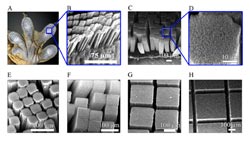Nanotube Adhesive Sticks Better Than a Gecko’s Foot

Microfabricated aligned multiwalled carbon nanotube setae and spatulas. (A) Optical picture of gecko foot showing that the setae are arranged in many lobes along the foot. (B) SEM image of natural gecko setae terminating into thousands of smaller spatulas. (E–H) SEM images of synthetic setae of width 50 (E), 100 (F), 250 (G), and 500 (H) µm. (C and D) Side views (C) and higher magnification SEM image (D) of the 100 µm setae. Image courtesy of the University of Akron.
In a paper published in the June 18–22 issue of the Proceedings of the National Academy of Sciences, the researchers describe a process for making polymer surfaces covered with carbon nanotube hairs. The nanotubes imitate the thousands of microscopic hairs on a gecko’s footpad, which form weak bonds with whatever surface the creature touches, allowing it to “unstick” itself simply by shifting its foot.
For the first time, the team has developed a prototype flexible patch that can stick and unstick repeatedly with properties better than the natural gecko foot. They fashioned their material into an adhesive tape that can be used on a wide variety of surfaces, including Teflon.
Pulickel Ajayan, the Henry Burlage Professor of Materials Science and Engineering at Rensselaer, and Lijie Ci, a postdoctoral research associate in Ajayan’s lab, created the material in collaboration with Ali Dhinojwala, professor of polymer science at the University of Akron, and University of Akron graduate students Liehui Ge and Sunny Sethi.
“Several people have tried to use carbon nanotube films and other fibrous structures as high-adhesive surfaces and to mimic gecko feet, but with limited success when it comes to realistic demonstrations of the stickiness and reversibility that one sees in gecko feet,” Ajayan said. “We have shown that the patchy structures from micropatterned nanotubes are essential for this unique engineering feat to work. The nanotubes also need to be the right kind, with the right dimensions and compliance.”
“Geckos inspired us to develop a synthetic gecko tape unlike any you’ll find in a hardware store,” Dhinojwala says. “Synthetic gecko tape uses ‘van der Waals interactions’ — the same interactions that hold liquids and solids together — to stick to a variety of surfaces without using sticky glues.”
The material could have a number of applications, including feet for wall-climbing robots; a dry, reversible adhesive in electronic devices; and outer space, where most adhesives don’t work because of the vacuum.
The research was funded by the National Science Foundation.
University of Akron Media Contact:
David Russ
(330) 972-6477
daveruss@uakron.edu
About the University of Akron
The University of Akron is the public research university for northern Ohio. It is the only public university in Ohio with a science and engineering program ranked in the top five nationally by U.S.News & World Report. Serving 24,000 students, the university offers approximately 300 associate, bachelor’s, master’s, doctoral, and law degree programs and 100 certificate programs at sites in Summit, Wayne, Medina, and Holmes counties. For more information, visit uakron.edu.
About Rensselaer
Rensselaer Polytechnic Institute, founded in 1824, is the nation’s oldest technological university. The university offers bachelor’s, master’s, and doctoral degrees in engineering, the sciences, information technology, architecture, management, and the humanities and social sciences. Institute programs serve undergraduates, graduate students, and working professionals around the world. Rensselaer faculty are known for pre-eminence in research conducted in a wide range of fields, with particular emphasis in biotechnology, nanotechnology, information technology, and the media arts and technology. The Institute is well known for its success in the transfer of technology from the laboratory to the marketplace so that new discoveries and inventions benefit human life, protect the environment, and strengthen economic development.
Media Contact
All latest news from the category: Materials Sciences
Materials management deals with the research, development, manufacturing and processing of raw and industrial materials. Key aspects here are biological and medical issues, which play an increasingly important role in this field.
innovations-report offers in-depth articles related to the development and application of materials and the structure and properties of new materials.
Newest articles

You are What You Eat—Stanford Study Links Fiber to Anti-Cancer Gene Modulation
The Fiber Gap: A Growing Concern in American Diets Fiber is well known to be an important part of a healthy diet, yet less than 10% of Americans eat the minimum recommended…

Trust Your Gut—RNA-Protein Discovery for Better Immunity
HIRI researchers uncover control mechanisms of polysaccharide utilization in Bacteroides thetaiotaomicron. Researchers at the Helmholtz Institute for RNA-based Infection Research (HIRI) and the Julius-Maximilians-Universität (JMU) in Würzburg have identified a…

ASXL1 Mutation: The Hidden Trigger Behind Blood Cancers and Inflammation
Scientists show how a mutated gene harms red and white blood cells. LA JOLLA, CA—Scientists at La Jolla Institute for Immunology (LJI) have discovered how a mutated gene kicks off…



